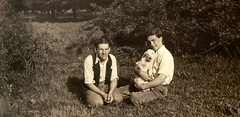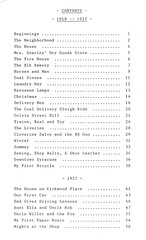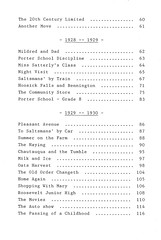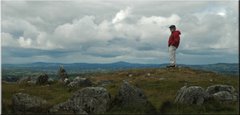Sensible. Unlike the Ft. Harrington raised beds, which were constructed in June of 2000 with overkill, over-build, over-complexity, and general over-the-toppishness. The hyperthyroid Ft. Harrington raised beds are even visible on Google Earth, if you know where to look.
But they were fun to build, and they are actually still there, in excellent shape, ready to pop out veggies on a season's notice.
We had lived in what would become "Ft. Harrington" for only one full calendar year when we decided that a garden would be wonderful, now that we had the space for it. We cleared the space you see above, which had been just a weedy, overgrown mess under previous owners. (It is also the leach field for our septic system.) We planted the tiny apple sapling at right, and staked out the locations for four 4x8 raised beds.
The material for the raised bed boxes is local redwood, which -- even untreated, as it has to be for this application -- is rot resistant. The corners are 4x4 pieces; the sides are rough planks. I had envisioned all four boxes as three planks high, but this first box convinced me that the others could be just two planks high.
 Short-box mass production -- Kelsey T. Dog, supervisor.
Short-box mass production -- Kelsey T. Dog, supervisor.Note the spiffy new fence at left. That is part of the new periphery fencing that Doug built (with Adam's and my help -- Doug, after all, was the carpenter, so we were the grunts). The fence was built during our first summer here, 1999, in order to allow us to get a dog. We wound up with Kelsey instead. (Just joking, big guy!) Note how skinny he is here; he was only a year and a half old at the time.
 New boxes at the ready.
New boxes at the ready.The planks are attached to the legs with high-calibre lag bolts, not wimpy nails or even screws, and the legs extend six inches below the bottom of the boards to be sunk into the ground for stability. These are the DC-3's of raised beds. They will last longer than our house. After Armageddon, cockroaches will use them for mansions.
 Moles, voles, or terrians can't claw up through this sturdy steel wire mesh at the bottom of each box. Well, terrians, maybe could, but they're not real. Or even highly-rated.
Moles, voles, or terrians can't claw up through this sturdy steel wire mesh at the bottom of each box. Well, terrians, maybe could, but they're not real. Or even highly-rated.The boxes are lined with heavy-duty black plastic sheeting for two reasons: 1) to eliminate water loss through the sides, and 2) to further retard any rot in the planks. Almost ten years after the boxes were built, there is no sign of any rot anywhere on any of them.
 Operational.
Operational.This view was taken in spring, 2004, in the fifth year of the boxes' operation. Three minor alterations can be seen: posts for jute webbing for a tomato cage on the tall box, a wire trellis for vines on the far box, and wide planks along the long edges of all of the boxes. The last serve as benches for comfortable, lazy gardening.





















